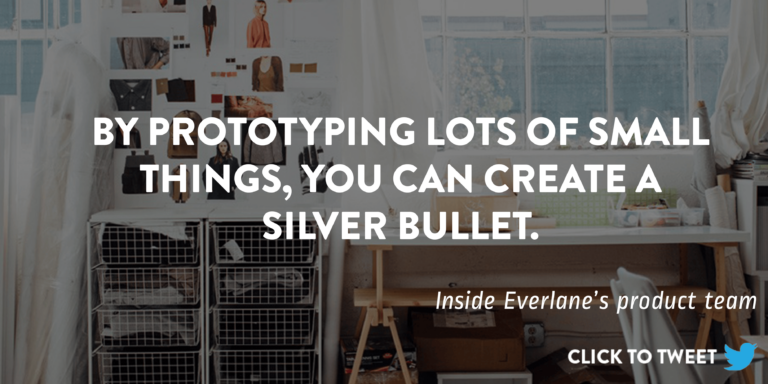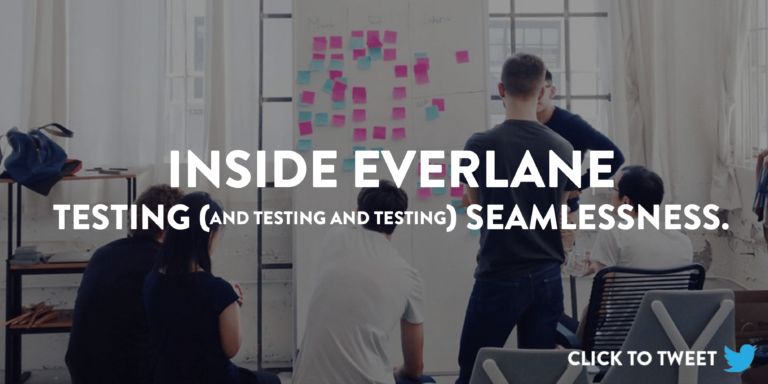Inside Everlane: Tailoring products to demand
It was a sandal, and although it had traveled a very long way, it revealed virtually no sign of distress.
Situated in the middle of Everlane’s SoHo popup, Shoe Park, the sandal sat alongside street shoes and modern loafers. In its big-windowed, cast-iron, pre-war building, Shoe Park in many ways resembled the other high-fashion boutiques just north, on Spring Street.
The difference?
Everything at Everlane may appear seamless, but it’s a calculated decision. Part clothing brand, part e-commerce startup, it’s had tremendous success designing and selling elegant basics. But its leadership wasn’t all that bullish on shoes. Shoes are a beast of burden; they cost a lot to manufacture, and it’s a rather crowded market. So Everlane experimented by releasing its shoes pair-by-pair, mirroring the startup’s general preference for items over collections.
Test after successful test, the shoes not only became a staple, they earned themselves a pop-up storefront in the fashion capital of the world.
But while Shoe Park may look sensibly chic, it’s a test too. The marketing team modeled it after product management’s point-of-sale design.
The flow, when a shopper walks into Shoe Park, was supposed to mirror the online experience. So was the forecasting. Everlane benchmarked foot traffic at the pop-up based on online metrics, such as how many people in New York use its one-hour delivery service.
And so Shoe Park isn’t a playground at all. It’s a website IRL.
The omnichannel
At the Stable Cafe, just a few steps from Everlane HQ in San Francisco, I settle in with product manager Alex “Amac” Maceda and lead data analyst Pauline Nguyen. We haven’t come together to talk about Everlane’s elegant basics (no, not even my marled navy sweatshirt). What I’m really keyed in is the other set of products being tailored in its Folsom Street studio: Technical Products.
One good way of thinking about Everlane as a business is supply-side products and demand-side products. Supply-side encompasses the creative and merchandising teams’ work: The really soft-looking wearable stuff. These items are designed by creative sensibility, not data. On the other hand, demand-side is devoted to more technical experiments that grow Everlane’s presence and accessibility.
Take Everlane Now, the startup’s one-hour delivery service in San Francisco and Manhattan. Why treat something as lush as slow-spun cotton yarn from Japan like a quickly cooling pizza?
The answer is “omnichannel.” To live online, but be strategically offline. The goal of an omnichannel strategy is making shopping as delightful and simple as possible through the introduction of unexpected channels. CEO Michael Preysman hasn’t espoused a Bezos-esque plan for market takeover (such aggression is off-brand), but a number of Everlane’s novel experiments seem to be in this vein.
“In-store retail has a lot of problems that online solves,” Amac says. “But we also totally own up to the fact that online has its own set of problems, so we’re always trying to make that shopping experience better.”

Data-woven
Recently, a coworker and I both took Everlane Now for a spin.
Needless to say, my courier won. Still, both messengers arrived in under an hour, delivering to me and her a medium-stripe crew shirt and a linen sweater, respectively. We gushed about the feature’s seamlessness, but it would appear it’s just as seamless on the backend.
Since exiting the test and iteration phase, Everlane Now has become mostly automated. These days it lives with one person. And this is the endgame for a technical product: To be automated with the help of engineers.
But it’s hard. Nothing in technical products is muse-inspired. Each idea needs data to substantiate its worth as part of Everlane’s omnichannel. And so before anything hits the desk of an engineer, its premise needs to be rigorously tested. The numbers have to bear out its value.
“The question you’re always working up against is, What is the cost of that engineering hour?” Amac says.
The upside of prioritizing products based on data is that it democratizes experiments. For instance, if someone wants to build a new feature, he can start testing an interesting customer behavior, tailor a hacky solution to that, and hopefully show high engagement.
When this works, it means exploring evermore ways of engagement simultaneously, without ever sending engineers on a needless errand. But there’s another potential bottleneck here.
If every decision needs to rubber-stamped by the data team, a small startup will suddenly find itself encumbered.
“Our team is seven people, but it’s not enough to support the entire organization in terms of analysts,” Pauline says. “We don’t ever want the data team to be a blocker.”
So, Everlane found a solution.
“For anyone at Everlane, you’re expected to understand data to some extent,” Amac says. “Data is woven into the culture.”
And since a lot of startups brag this way, Pauline puts it in perspective quantitatively: “50% of the company knows SQL or can manipulate it in some way.” That ranges from product management to marketing and even to customer experience. And then as if punctuating, she adds, “Not just drag and drop.”
This is Everlane’s ingenious way of threading the needle. The data team isn’t holding people up, because everyone can at least write a simple query. The engineering team isn’t held up, because only proven experiments get developer resources. In the space between, there are the product managers, running a lot of cool tests simultaneously.
Test & Iterate
Amac had a theory about getting higher engagement from newer customers.
She mapped out a clienteling service called Assisted Commerce. The idea was to proactively connect customers with a member of the customer support team to check-in on their experience and recommend them new items based on their purchase. Hypothetically, a clothing playlist is the type of thing that lends itself to automation. But she needed to prove its worth first.
With no engineering resources and just a hunch, she had to ask herself, What is the simplest way to do this test?
“We created Gmail accounts, pulled those customer lists, and started emailing them,” Amac says. “We had incredibly high response rates, if only just to say thank you for a personal e-mail.”
New customers, however, weren’t looking for a personal shopper. Nevertheless, she had already begun running the test. So, she broadened the emails to the entire customer base, did some data cuts, and located a very responsive segment.
“There was a positive signal coming from a group of top female customers—women who had shopped with us multiple times.”
So while Assisted Commerce might not solve the problem of re-engagement, it revealed an untapped channel. There was a lot to learn from this upper tranche of Everlane customers. The team began emailing with these highly-engaged shoppers, and Assisted Commerce was refitted as Concierge.
“Concierge is, in a lot of ways, the new experiment,” Amac says. “We haven’t actually built a smart algorithm that would fill the box we would want to send to our Concierge customers. Our stylist team is manually doing it. But as they learn more, it’s easy to imagine us automating pieces for them. I feel like everything’s an ongoing experiment.”
The more they drill into these responsive segments, the more risks they can take across channels.
“There’s no one-size-fits-all shopping experience, so we’re constantly trying to make the general site experience better,” Amac says. “But when you really want to move the needle, it’s often that you find a customer segment a particular feature speaks to, and they respond really, really well.”
Out of the box
Most of the tests being run at Everlane land in front of the data team at some point. Because of this, Pauline has a pretty full understanding of what everyone’s working on. She can also identify which experiments aren’t being explored.
The data team had identified a segment of customers that none of the other teams were experimenting with. This particular segment was problematic. They purchased, but didn’t return, and nobody was sure why. After several discouraging tests, the data team was still unsure how to get this segment to repeat.

One theory was that this group of shoppers had an anxiety common to ecommerce. They couldn’t conceptualize what their clothes would look like in-person. This shopper was afraid that the shirt would present well in pixels, but then hang off the shoulders wrong.
So the team emailed one part of this contingent, asking if they would like to try clothes at home. No huge blip. They emailed another with the same question: How would you feel about a subscription service? The numbers weren’t huge there either. But across tests they discovered an overlapping trait among respondents: Men were interested in such a subscription service.
“At the beginning of the project, the goal had been to target women, because they’re a majority of our business,” Pauline says. “We weren’t focused on men, but now it’s turned into this men’s subscription test that we’re continuing to prototype.”
There isn’t really a formal point for transitioning a well-tested experiment into an engineer’s load. When it feels like it’s taken off, a la Everlane Now, it’ll make sense.
The portfolio
Many of the technical products and tests, when looked at side-by-side, make up a strange ensemble. What is the governing aesthetic across a one-hour delivery service and a subscription plan? And yet when I reflect on my own purchasing behavior, across many of these channels, it feels like a seamless experience. It feels sleek.
“What we’ve definitely found, prototyping these small things, is that you want to build a portfolio of all these tiny, really powerful lead bullets,” Pauline says. “Together, they could create a silver bullet.”
Everlane sees infinite possibilities, even with finite engineers. The hack here is to get employees curious, involved, and running tests upfront. The cost of an engineering hour can be expensive, but hopefully a startup’s product managers are teeing up lots of stellar products for the assembly line.
The startup has a quiet confidence about its omnichannel. It shares that sentiment common with a lot of tech companies growing smartly: We could be so much bigger tomorrow — if we wanted to be.
And yet one gets the sense, with Everlane’s meticulous testing, that the team is being truthful.
The emperor does wear clothes, and they just arrived in a svelte, grey delivery box by bike courier. Anything is imaginable, so long as it can go the distance.



